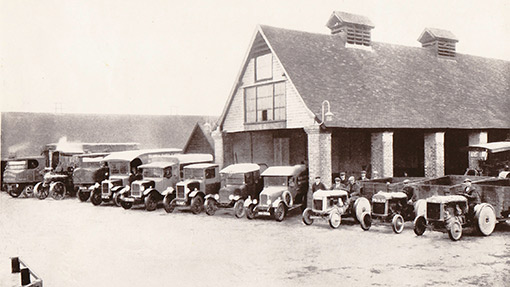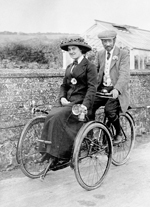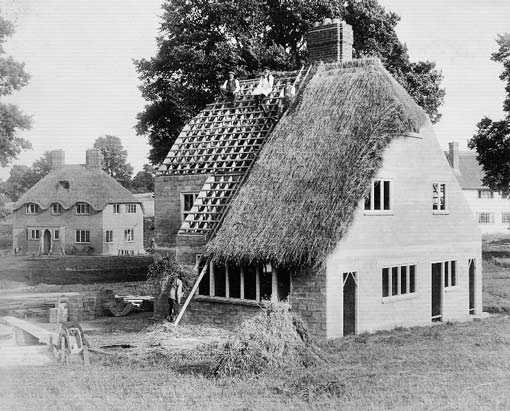Inspirational Devon farm estate celebrates centenary

A hundred years ago, Ernest Debenham founded the great Bladen Estate, making the little village of Briantspuddle home to one of the most important and forward-thinking agricultural businesses of its time.
In April 1914, the grandson of the founder of Debenhams Drapery and Department Stores bought a number of farms around the village. Altruistic and an astute businessman, he aimed to combat unemployment problems in the countryside by merging good business and marketing ideas with cutting-edge agricultural techniques, managing the supply chain from plough to plate.
“His vision,” says local historian Sue Taylor, “was to put into practice his advanced ideas on experimental and self-sufficient agriculture.”
See also: How tractors helped to win the war
By 1928, the Bladen Estate comprised more than 10,000 acres, with 1,200 cattle including pedigree Guernseys, Shorthorns, Aberdeen Angus and cross-bred Guernseys. In addition there were 3,500 breeding pigs, 3,500 breeding sheep, 70 stocks of bees and a 250-acre poultry farm producing free-range meat and eggs.
“The pedigree herds were established with the help of Prof Boufleur, head of Cirencester Agriculture College, with detailed records kept of breeding, feeding and health,” says Sue. “Ernest Debenham aimed at the highest standards of milk production, with constant testing in the bacteriological laboratory.”
As the dairy grew, Sir Ernest’s son Martin set up Ideal Home Dairies; later to become Express Dairies, processing 10,000 gallons of milk a day for liquid consumption and 10,000 for cheese and butter. Steam generators produced electricity for the dairy, with the exhaust steam used to pasteurise the milk.

“Another innovation was the use of paper cartons – 50 years ahead of Tetrapak – which were lighter to transport and kept the milk fresh for longer,” says Sue. “The story goes that a consignment was shipped to Rhodesia and arrived as fresh as when it left home; part of the shipment was returned and it was still fresh when it got back.”
Sir Ernest’s sister Alice managed the farms, and later went on to become one of the founder members of the Soil Association with Lady Eve Balfour.
To feed the livestock, she grew a mixture of arable crops, with grass leys, lucerne, cabbages and mangels. There was also processed whey from the dairy, and Sir Ernest established Thames Milling at Erith, Kent, to import raw materials for processing into balanced livestock rations.
“There was also an on-site veterinary practice, with the dairy cows inspected weekly and vaccinated against TB every six months,” says Sue. “Other stock was also regularly inspected, with postmortems carried out if any animal died.”
Pedigree and cross-bred pigs were bred on the Estate, with the primary intention of producing bacon pigs weighing 200-220lb at six-and-a-half months. Sows had access to pasture before farrowing and were then housed in roomy sties with farrowing rails – a concept way ahead of its time.

“The poultry farm featured an egg grading station and an incubator room that could hold 48,000 hatching chicks,” she adds. “They were then moved into brooder and laying houses with access to pasture, with the West of England Egg Producers Company set up to offer a collection point for local farmers wanting to sell eggs through the new National Mark scheme.”
Pedigree and cross-bred sheep lambed all year round, with Dorset Horns put to a terminal sire twice a year, and lambs given creep feed produced by the Thames Milling Company.
As well as nurturing the soil to boost yields, Alice and Ernest planted fruit trees and commercial firs, as well as hardwoods, hazels for hurdles and willows for cricket bats.
To house the farmworkers, livestock and machinery, Sir Ernest carried out a major building project, obtaining most of the building materials from the estate and designing buildings that would sit in harmony with the Dorset landscape. “All the houses had electric lights, pumped water, indoor bathrooms and a quarter of an acre garden, with an orchard and pig pen to encourage self-sufficiency.”
The powerstation – now Bridge House – produced electricity for the estate, and the transport yard housed two steam wagons, 16 tractors, six vans and lorries, eight cars and 12 motorcycles.
“Sir Ernest farmed in a way that was well ahead of his time, producing stock and crops of the highest quality,” says Sue. “He severed all connections with the family drapery business, selling his shares in 1927, and in 1931 he was created a baronet in honour of his services to agriculture.”
Unfortunately, the recession in the 1920s began to catch up with the estate, and 19 farms were sold off in 1943. “However, the dairy remained very successful, contributing hugely to food production during the Second World War.” Sir Ernest died on Christmas Day 1952 at the age of 87, and a large part of the estate had to be sold off to meet death duties.
“Sir Ernest’s sons, Gilbert and Martin, continued to farm, and Rose – a direct descendant – still farms in the area,” says Mrs Taylor.
“He was undoubtedly one of the country’s foremost pioneers in agriculture. Sadly, his vision of increased production leading to increased employment on the land has not happened. Fewer people work the land now than at any other time in history; yet production has increased enormously, using the scientific methods that Sir Ernest established.”
A lasting legacy
Rose Debenham still farms at Turnerspuddle Farm, continuing Sir Ernest’s legacy of sensitive yet commercial agriculture. “I’m a strong believer that we’re just caretakers of the land and buildings for future generations,” she says.
“My father died 23 years ago and lots of people told my mother to sell up. It’s thanks to her determination to keep it going that I was given the opportunity to farm myself.”
The farm extends to 700 acres, comprising a mixture of arable land, water meadows, heathland and grass leys. “We’ve got a commercial suckler herd and a small herd of North Devon cattle to graze the heath,” says Ms Debenham.
“Sir Ernest progressed the farms a long way in a short time, and he was highly inspirational – one of a kind. He was very well thought of, because he looked after his workers so well, and a lot of his ideas have been carried forward.”
The farm still has working gravel and chalk pits, but mechanisation means little else remains the same. In its heyday, says Rose, the estate had thousands of workers, but farming has now changed beyond belief.
“Even our own farm used to have 17 people working it when I was a child; now there are just two of us. But the ethos is still there.”
